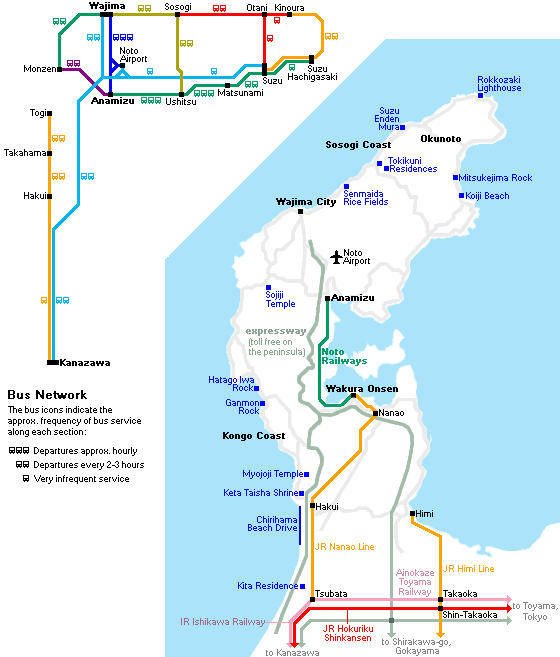Wajima City

Wajima City (輪島) is the largest city in the Okunoto region, which makes up the northern half of the Noto Peninsula. The city is centered around a protected harbor on the Sea of Japan coast and is most famous for its morning market and lacquerware.
Wajima's Morning Market (Asaichi in Japanese) is the city's most famous attraction, believed to date back over a thousand years. Daily between 8:00 and 12:00, the pleasant pedestrian street in the city center is lined with vendors selling various goods, including fresh seafood and produce. Elderly women, who bring in their goods from local farms, contribute a lot to the market's character.

Also on sale at the morning market is lacquerware, the city's most well known handicraft. Known as Wajima-nuri, the local lacquerware is distinguished for its durability, which is achieved from extra stages of coating. To create a single piece of Wajima lacquerware requires a number of specialized artisans and dozens of processes. There are two museums dedicated to the local specialty: the Wajima Nuri Kaikan and the Wajima Museum of Lacquer (Urushi) Art.

Located a short walk from the morning market, the Wajima Nuri Kaikan has two floors, and only the museum on the second floor requires an entrance fee. The first floor is a shopping area, where a large number of lacquer products are on sale. The Wajima Museum of Lacquer (Urushi) Art, located a bit outside the city center, has a wider variety of lacquerware on display in a nice atmosphere conducive to admiring the works.
Another interesting attraction is the Kiriko Hall, a museum for the massive illuminated festival floats known as kiriko. The floats are used between July and September during summer and autumn festivals of the Noto Peninsula. The Kiriko Hall has a few rooms with exhibits about the festivals, but the main attraction is the floats themselves, which are on display in the main hall. Kiriko can be as tall as 15 meters, and usually have kanji written on one side and a dramatic illustration on the other.

Getting there and around
How to get to Wajima
Wajima is no longer connected to the railway network. Instead, take the bus from Anamizu (30-50 minutes, 760 yen, hourly departures), the terminal stop on the Noto Railway. Some direct buses to Wajima are also available from Kanazawa (about 2 hours, 2300 yen one way).

How to get around Wajima
Wajimaeki-mae is the main bus stop in the city. Buses from Anamizu terminate at Wajimaeki-mae, while buses from Kanazawa continue on to Wajima Nuri Kaikan before terminating at Wajima Marine Town. The morning market, Wajima Nuri Kaikan and Kiriko Hall are all short walks from the Wajima Marine Town bus terminal. The Wajima Museum of Lacquer (Urushi) Art is a 20-30 minute walk away. By bus, the museum can be reached from Wajimaeki-mae by the Noranke community bus (10 minutes, 100 yen one way, one bus every 60-90 minutes).
How to get to and around the Noto Peninsula

Hours and Fees
Morning Market (Asaichi)
Hours
Closed
Admission
Wajima Nuri Kaikan
Hours
Closed
Admission
Typical Visit Duration
Wajima Museum of Lacquer (Urushi) Art
Hours
Closed
Admission
Typical Visit Duration
Kiriko Hall
Hours
Closed
Admission
Typical Visit Duration
Questions? Ask in our forum.


